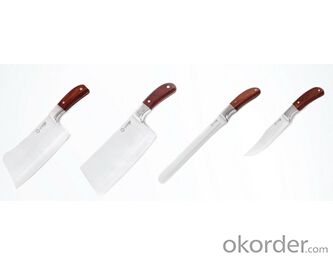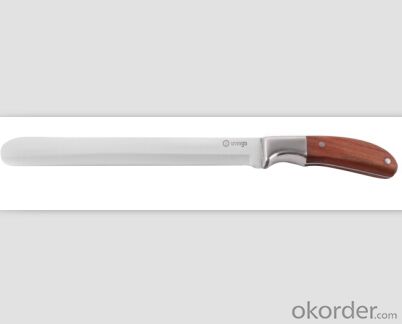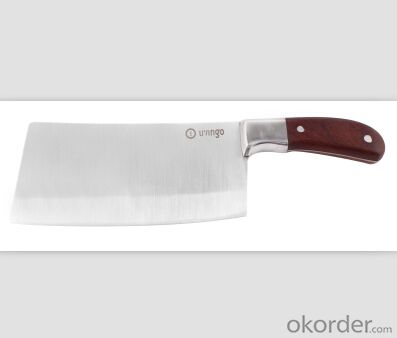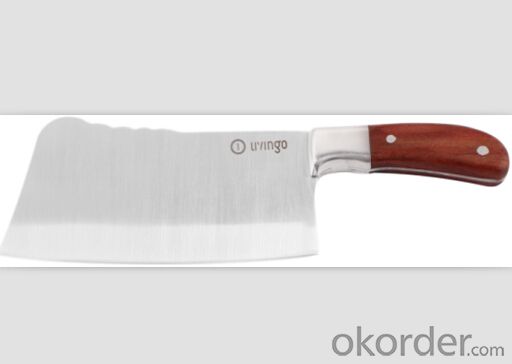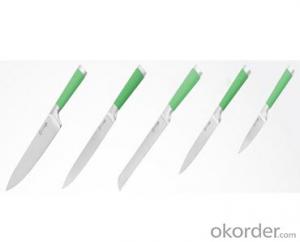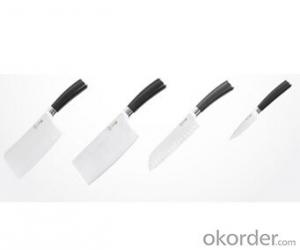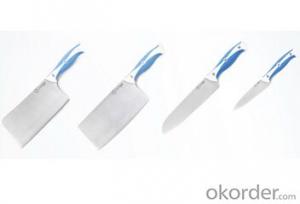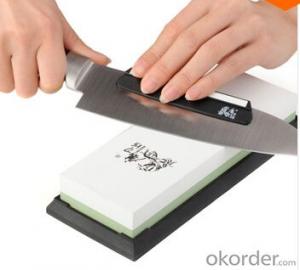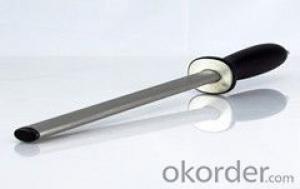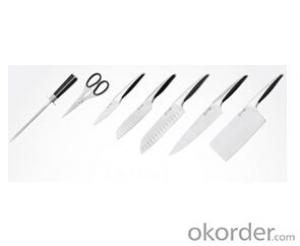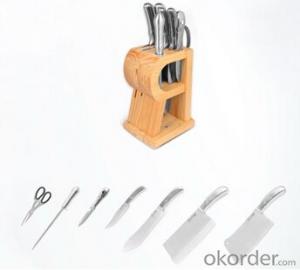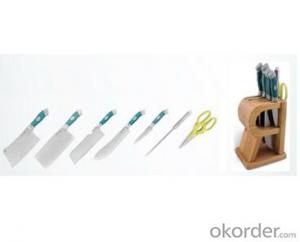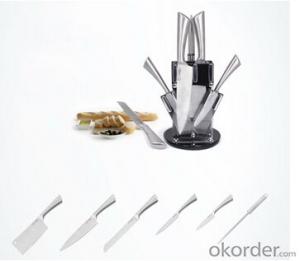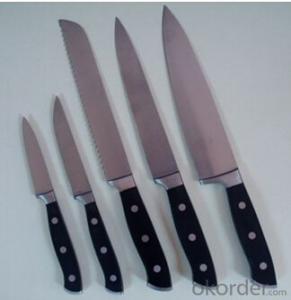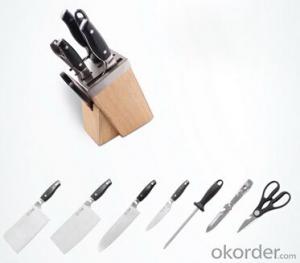Art no. HT-KS1002 Stainless steel knife set
- Loading Port:
- Guangzhou
- Payment Terms:
- TT OR LC
- Min Order Qty:
- 1000 PCS
- Supply Capability:
- 100000 PCS/month
OKorder Service Pledge
OKorder Financial Service
You Might Also Like
Set includes:
1 × chopping knife
1 × cleaver
1 × bread knife
1 × fruit knife
High-carbon stainless steel blade holds a superior sharp edge
High quality stainless steel,tool vertical tough strong corrosion resistance
Easy to use, easy to clean
Comfortable grip handle for balance and control
Many other designs are available
Customized orders are accepted
Product advantages:
Wear resistant & extremely durable
Deathly sharp & stay sharp for years
Easy to clean to prevent bacteria growth
Blade high in density, chemically inert will not rust and do not react with acidic, food keep its original taste. No metal taste and smell
Care instruction
Do not use knife on stone chopping block
Do not use to chop of pry as this may chip the tip of knife or the blade to break free from the handle
Blade is very sharp. Please prevent children from touching
- Q: What tools have both toughness and wear resistance
- Sintered carbide tool:Carbide tools for powder metallurgy products, tungsten carbide cutting tool is mainly composed of 50%~90% tungsten, and add titanium, molybdenum, tantalum and other cobalt powder as binder, and then completed by heating sintering. Carbide tool hardness than any other materials are high, three times the most hard of high carbon steel, suitable for cutting hard metal or stone, because of its hard brittle material, it can only be made into slices and then welded to handle more toughness, so cutting edge passivation or crack, can replace another knife or mouth a new blade, this tool is called disposable tool enough.
- Q: What tools are used for machining stainless steel
- The main tool is selected angle. It is the processing difficulty. Good toughness red hardness. The tool wear and poly. Choose a sharp cutting tool is good. High speed steel and hard alloy cutter can be, the main attention chipbreaker and tool angle.
- Q: What are the advantages of ceramic knives?
- Non metallic ceramic knife is excellent, it has never rust characteristics, we do not have to worry about the residual water stains will make the blade rusting.We use the newly bought steel was corroded or too clean steel, will find it cut food with iron smell, this is because the metal ions emitted by knife attached to the food, can eat up a strange feeling. This phenomenon will not appear on the ceramic knife, it allows you to enjoy the food is 100% authentic.
- Q: YG813 carbide tools can be intermittent turning stainless steel? How much is the cutting speed?
- YG type alloy impact resistance is good, can be used for intermittent turning stainless steel, cutting speed of 80m/min, high concentration of emulsion, about 8%, of course, if there is a better class YW alloy, wear resistance, thermal hardness and hardness are higher
- Q: What is the role of shield machine tools
- Fishtail knifeThe whole section cutter cutting soil, arranged in a different position on the cutting knife, knife disc from Zhouzhi center, full moon movement decreases, center theory can be regarded as zero. In other words, the length of the cutting soil in the sealed cabin is gradually reduced from the outside to the inside.
- Q: I know that there are two numbered Rules, one of which is T0101, T0202, T0303, T0404, etc.There is a T0101, T0102, T0103, T0104, such as the number, under the advice of the two numbersCan it be mixed? If you can, how to determine the knife mark?
- The knife, it is a knife, you have to use the knife number corresponding to the use of which is fixed, the machine is a knife, do not switch on the changes in the number of cars, one of the top two, T05XX, is called No. 5 and No. two knives, behind the ah. The knife is partial, commonly known as the cutter compensation, each knife generally corresponds to a knife, but there are exceptions (45 partial knife two tip, can have two cutter compensation), in order not to mess up, we generally used is the number corresponding to the number of knife cutter compensation, such as No. 3, No. 3 knife knife, namely T0303, No. 6, No. 6 knife knife, T0606, this is what you said first, second, and you say almost no, because a knife a knife up enough, in order to facilitate a clear but not easy to be mistaken in the first case.
- Q: How to distinguish between YG tool and YT tool and YW tool appearance
- This is the time to pay attention to the tool than when. There is a big gap between the brand.
- Q: What is the difference between insert and cutter
- A big difference, the former is welded on the operation, trouble, after welding, grinding to open front, trouble, but the economic, however, if there is no special grinding tools like disposable almost, the latter is directly replaced by screws can, convenient blade welding blade than your price many, usually in 20 to 40 yuan a
- Q: What is the relative motion between the tool and the blank?
- 1 processing of standard gear: standard rack cutter indexing line and the blank of the dividing circle tangent and do pure rolling2 (processing) into the gear: standard rack cutter line deviation from its pitch line a bit XM, the line and the blank of the dividing circle tangent and do pure rolling.Problems can contact, hope to adopt.
- Q: What are the features of the CBN tool?
- Because the CBN tool can be better than 0.4 m surface finish and maintain concentricity + 0.012mm, Dry Turning Hardened workpiece is usually a dirty alternative attractive strengthening grinding cooling scheme. Although CBN is a kind of tool material which is hard to be used in high speed and high speed milling, the range of application of ceramic and CBN is very much, so it is necessary to use cost benefit analysis to decide who can get the best result.
Send your message to us
Art no. HT-KS1002 Stainless steel knife set
- Loading Port:
- Guangzhou
- Payment Terms:
- TT OR LC
- Min Order Qty:
- 1000 PCS
- Supply Capability:
- 100000 PCS/month
OKorder Service Pledge
OKorder Financial Service
Similar products
Hot products
Hot Searches
Related keywords




